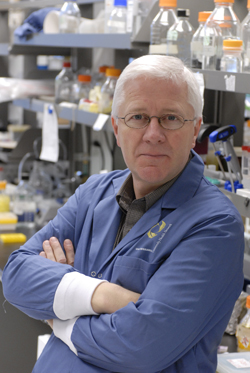Cancer scientists led by UHN's Dr. John Dick, along with collaborators at St Jude Children's Research Hospital in Memphis, have found that defective genes and the individual leukemia cells that carry them are organized in a more complex way than previously thought.
 The discovery, which has been published in the journal Nature, challenges the conventional scientific view that cancer progresses as a linear series of genetic events and that all the cells in a tumour share the same genetic abnormalities and the same growth properties.
The discovery, which has been published in the journal Nature, challenges the conventional scientific view that cancer progresses as a linear series of genetic events and that all the cells in a tumour share the same genetic abnormalities and the same growth properties.
"Our results show this is not the case and open the way to discover how genetic abnormalities transform normal cells into leukemic cells and the steps that have to happen to make the leukemic cells increasingly abnormal and aggressive, how leukemic cells at different steps of genetic evolution (or progression) respond to therapy, or contribute to relapse," says Dr. Dick, Senior Scientist at the Ontario Cancer Institute's Campbell Family Institute for Cancer Research at PMH, and the McEwen Centre for Regenerative Medicine, UHN.
The research team found that the leukemia cells taken from patients with acute lymphoblastic leukemia (ALL) are actually composed of multiple families of genetically distinct leukemia cells. They looked at how these families developed and retraced the ALL "family tree" back to its origins. They discovered that the so-called black sheep—the cells that propagate the disease and potentially survive therapy—persist through generations, and even branch off and evolve to form genetically distinct cancer families. Some of these genetic families dominate, making it appear that the leukemia cells only have one set of genetic abnormalities while other families are very rare, explaining why they had never been seen before.
This insight into genetic diversity has positive implications for cancer treatment, says Dr. Dick: "Understanding the complexity of cellular relationships and the existence of distinct genetic families of leukemia cells will shed light on why some cells of the cancer are not killed by the therapy and eventually re-grow resulting in disease relapse, and help accelerate the development of tailored therapies to wipe out all the unwanted branches in the genetic tree."
The current research builds from earlier findings published in 2007 when the Dick team developed a method to convert normal human blood cells into "human" leukemia stem cells. The converted cells can replicate the entire disease process from the very moment it begins.
